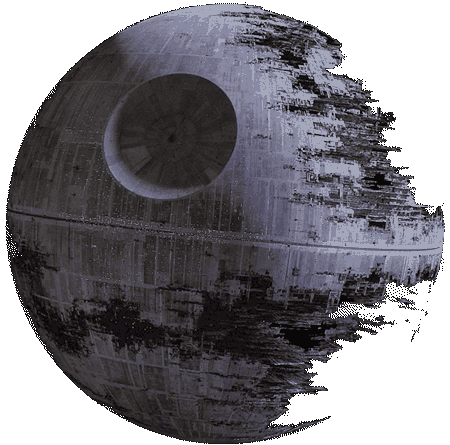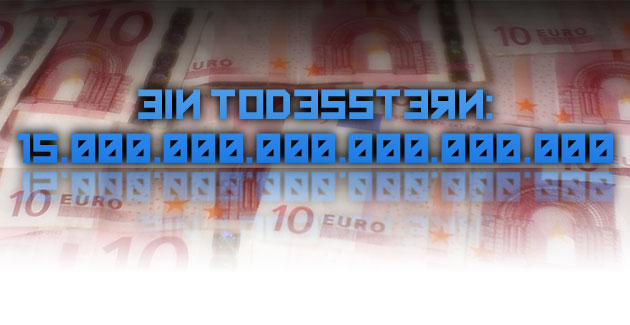Ein Todesstern für 15 Quadrillion
Das es im Internet zu jeder Frage eine passende Antwort gibt, sollte den meisten Leuten mittlerweile bekannt sein. Das Unglaubliche dabei ist nur: Es gibt WIRKLICH zu JEDER Frage eine Antwort, sogar zu solchen, welche Personen mit einem gesunden Menschenverstand niemals fragen würden. Zum Beispiel diese: Wie viel Dollar würde der Bau eines Todessterns kosten? Basierend auf der Menge der benötigten Materialien und deren Materialkosten, Transportkosten, Löhne der Arbeiter und vielem mehr hab ich eine ausgiebige und glaubwürdige Aufstellung der geschätzten Gesamtkosten gefunden. Ein einzelner Todestern würde demnach exakt 15.602.022.489.829.821.422.840.226 Dollar und 94 Cent kosten. Das sind – in Euro umgerechnet – knappe 12.034.883.100.000.000.000.000.000 1-Euro-Münzen. Also 12 Quadrillion Euro. Nachfolgend findest du den originalen englischsprachigen Artikel, welchen ich auf www.rickgold.info fand.
PS: Nebenrechnung. Solltest du einen Todesstern in Auftrag geben und in 1-Euro-Stücken bezahlen wollen, würde dieser Euro-Berg satte 90.261.623.250.000.000.000 – also 90 Trillionen – Tonnen wiegen (Ein 1-Euro-Stück wiegt exakt 7,5 Gramm)! Das sind 1,36 Prozent des gesamten Gewichtes der Erde. Und diese wiederum wird auf 6.600 Trillionen Tonnen geschätzt. Gut, genug der Mathematik – viel Spaß beim Lesen und an-den-Kopf-fassen:
One Death Star for $15 Septillion? What a deal!

A very, VERY large number, especially when it concerns money. And why is it a deal? Because that figure ignores a lot of very important costs. Costs for what? Why to build a Death Star of course!
One evening sitting on my rather run down couch, channel surfing, I came across Star Wars: Return of the Jedi. The scene I happened to tune in to featured multitudes of little space ships flying in and around Darth Vaders behemoth of a killer space station, the Death Star.
Thanks the magic of ILM and the imagination of the series creator George Lucas, we get the scale of this phenomenal construct. You see “spacescrapers” towering over the surface of the moon-like station, valleys that would put the Grand Canyon to shame, and a virtually level horizon line.
While watching this, an odd question popped into my head, “How much would it cost to build the damn thing?“. Impossible to figure out? Truthfully … yes. A complete and utter waste of time, absolutely! So why not try and find out!
I got a question …
Judging by the figure up there, you’ll know why The Emperor was so pissed when the rebels destroyed his monstrosity, and why he was clearly running low on his budget for the second!
So, the “yes” part up there; there are way too many variables to take into consideration to get an accurate cost on a God-like project like this. Hell, it’s science fiction, it could have been constructed by the snap of some Q-like entity’s fingers. But let’s forget Q’s, Darth Vaders, and an entire bag of impossible things to calculate, and answer what we can.
After boiling it down, I ask this question: “In US dollars, what would the cost of materials and delivery to space be for the Death Star?“
So there we go, and yes … I’ve completely ignored such pesky things like cost of ground transportation, cost of construction in space, variety of material costs, time of construction and change of economy over time, gravitation effects, whether or not slave labour was used, why did Darth Vader wear black, and many, many other things. If you care to try and take a stab at any other aspect I’ve otherwise ignored, be my guest! This was for fun, not accuracy …
A very big Death Star
So, first off, what do I base this all on? How about some educated, but none the less arbitrary numbers? Lets say that the Death Star is 1/10 mass for volume. That means 1/10 of the total volume of the DS is something other then empty space or air. And lets say, 6/10 of the total volume is pressurized, livable space. If that sounds off to you, to bad, write your own article, otherwise, keep reading.
Using those numbers, lets find what we would need for the most basic of building materials and living requirements, steel and air. Thanks to the internet, we can get all sorts of information on those two things, and come up with fun and impossibly large numbers regarding them!
To start our calculations, we need one very important piece of information, just how big is the DS? Thanks to Jeff Russell at www.merzo.net, and his vast database of speculative Star Ship Dimensions, we have an “Official” diameter of 160km’s.
Side note: From here on in I’m going to state decimals and the number, you can find the actual numbers in the “Check My Math” section below.
Nasty calculations
That gives us a volume of 17.16 quadrillion cubic meters. At 1/10 volume, we’ll need 1.71 Quadrillion cubic meters of steel, weighing in at 134 quadrillion tonnes. In 2008 steel products, from wire to ingots were selling for an average of $962 per tonne, so our cost of steel alone is $12.95 quintillion.
Now, how about getting that into space? According to the numbers I could find on the internet, it costs around $95 million to ship 1 tonne of materials into space, so that means we’ll be cutting NASA a cheque for $12.79 septillion. (Remind me to order larger cheques from the bank please.)
Now how bout the air? Air is largely Nitrogen(80%) and Oxygen(20%), and rather conveniently we can ship it compressed. How much are we going to need? 8.23 quintillion m³ of Nitrogen, and 1.65 quintillion m³ of Oxygen. These compress by a very large factor; we’ll only need to ship 21.06 trillion m³ of Nitrogen, and 1.96 trillion m³ of Oxygen. (Credit 1)
Our Nitrogen is going to weigh in at 17.03 trillion tonnes, and our oxygen will tip the scales at 2.24 trillion tonnes. Cost of delivery? Get that pen out and write one of those oversized checks for $2.81 Septillion, and $212.46 quintillion.
Add it all up, and we have a figure of exactly $15,602,022,489,829,821,422,840,226 and 94 cents. Tell you what, I’ll pitch in the 94 cents.
That is a lot of money. Wait, no that’s a disgustingly large sum of money.
How much exactly? $15 Septillion, I told you. But how can we conceive of that number? Well, the figures I could find for the World Economic Value were pretty general, around $14 Trillion USD. In other words, the DS would cost 1.11 TRILLION times the amount of money available in the world, that’s not even including the fact that the majority of that is digital and not physical.
For comparison only …
How about something else? Say, how much is the Iraq war costing? You see all sorts of calculators out there, but one figure says $343 million per day, and that is a huge waste of money! But you know what? The Iraq war would have to last 124 TRILLION years, or 9,730 time the age of the UNIVERSE to equal the costs of building one measly Death Star. I mean, come now … it’s only one.
One more interesting number, 10.3. That is the number of Death Stars it would take to contain the $15 Septillion to build ONE of them! (Credit 4)
On a positive note, our construction efforts would only require 0.005% of the Earth’s atmospheres available Nitrogen … and only 0.002% of our oxygen to fill it up. So, if the US Military ever gets into it’s head to build one, we may go broke over the shear costs of printing presses, but at least it won’t be harder to breathe. 🙂


2 Kommentare
15,602,022,489,829,821,422,840,226$ sind aber meines wissens nicht 15 septillionen… man kann ganz einfach der stelle nach gehen es fängt an mit ein -ern, tausend -ern, millionen, milliarden, billionen, billiarden, trillionen, trilliarden, quadrillionen, quadrilliarden, quintell- oder quinquillionen(bin mir nich ganz sicher wie es heist) usw…
und wenn man das nun auffächert kommt man auf:
226 x eins
840 x tausend
422 x millionen
821 x milliarden
829 x billionen
489 x billiarden
022 x trillionen
602 x trilliarden
015 x quadrillionen
für interresse: die zahlennamen kann man heir gut nachlesen: http://de.wikipedia.org/wiki/Zahlennamen#Billion.2C_Billiarde_und_dar.C3.BCber_hinaus
Zitat einfachich ↑:
Danke, du hast natürlich vollkommen Recht! Ich vergaß die korrekte Umwandlung der verschiedenen Zahlenbezeichnungen 🙂 Im American- und British-English lautet die Auflistung der Zahlen der Größe nach geordnet wie folgt:
Million = bei uns Million
Billion = bei uns Milliarde
Trillion = bei uns Billion
Quadrillion = bei uns Billiarde
Quintillion = bei uns Trillion
Sextillion = bei uns Trilliarde
Septillion = bei uns Quadrillion
Octillion = bei uns Quadrilliade
Thread closed